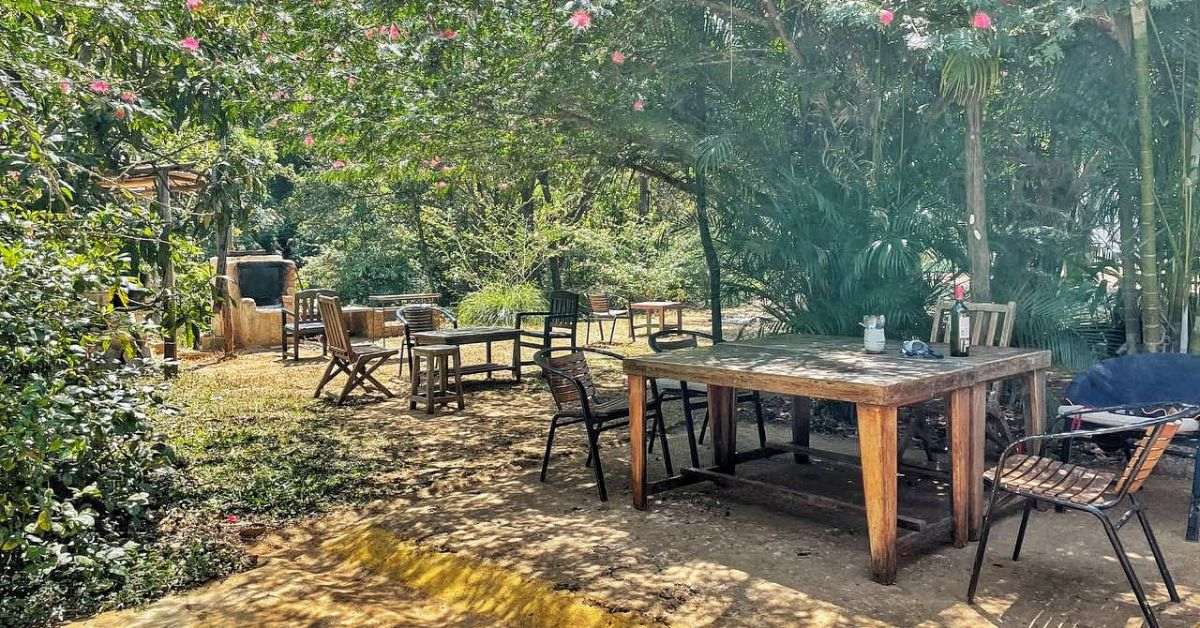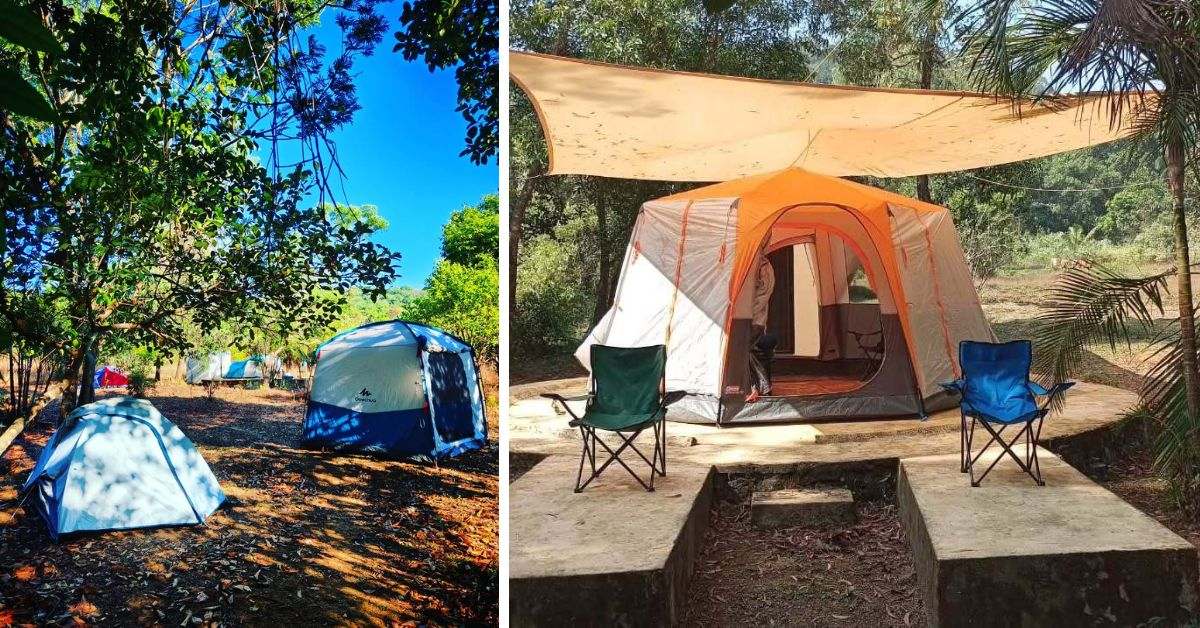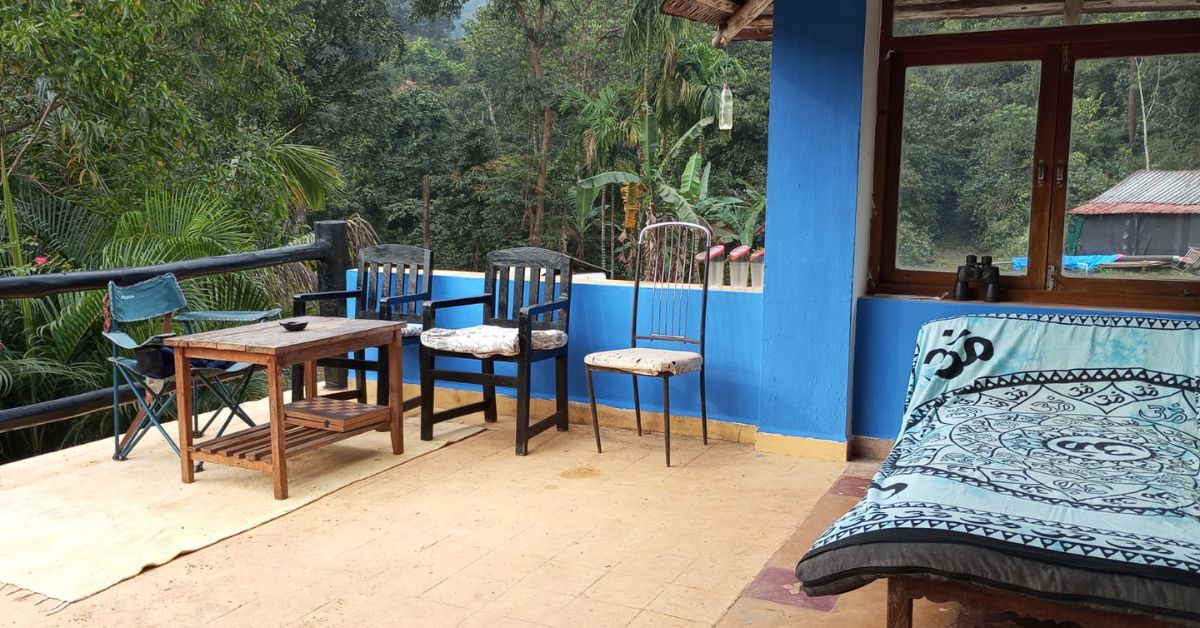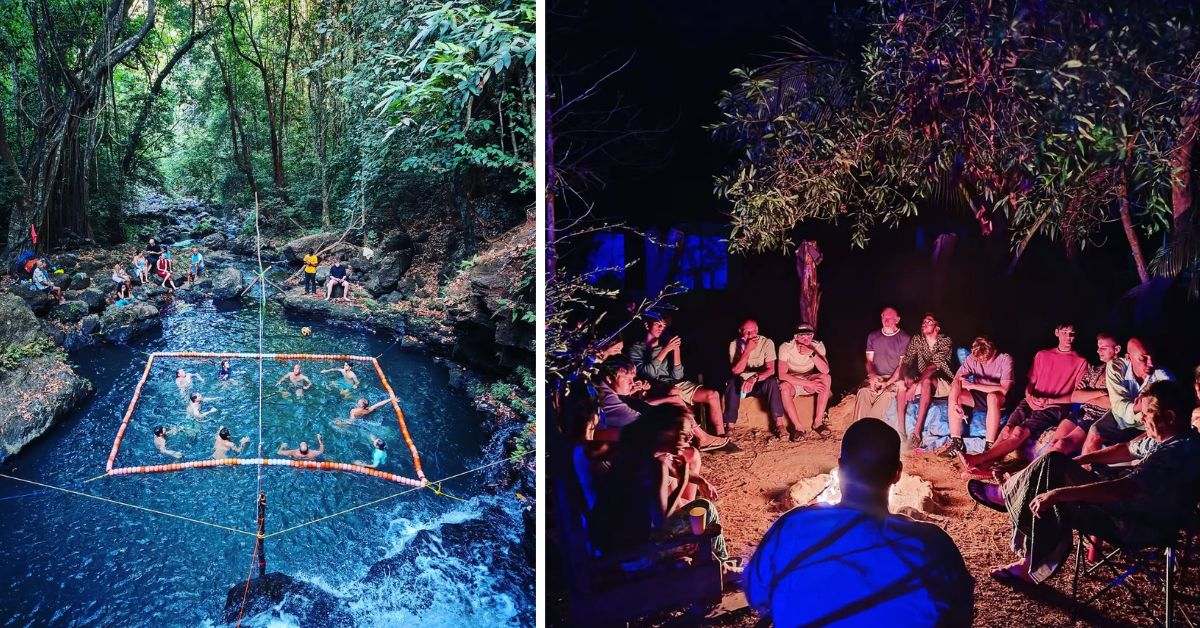How a Former Journalist & a Rafting Pioneer Couple Built a Forest Retreat Without Electricity
In a forest 60 km from Dandeli, where the sounds of traffic are replaced by cicadas and the nearest mobile signal is a trek away, stands a home that runs not on electricity, but on intention.
There are no fences to keep the wild out and no switches to flip — only fireflies to light the night. This is Off The Grid, a rustic forest retreat situated in a 2500 sq km area, built and run by a couple — Sylvia Kerkar, a former journalist turned potter, and John Pollard, a pioneer in white water rafting.
At 56, the couple leads a life as grounded and steady as the clay Sylvia shapes every day — a stark contrast to her former world of deadlines and newsrooms.
An eight-year journey as a journalist
Sylvia began her career in 1987 by pursuing a degree in hotel management at the Institute of Hotel Management, Catering Technology and Applied Nutrition (IHMCT&AN) in Bengaluru. But it didn’t take long for her to realise that her true passion lay in writing and storytelling.
“I had already started writing for my college, and I was doing a bit of freelance writing for the Times of India and three other publications,” adds Sylvia. “Because I wasn’t formally trained as a journalist, I had started building up my portfolio via freelancing and writing stories,” shares Sylvia, who has also worked with the Economic Times.
Sylvia moved to Dubai in 1996, where she worked for the Gulf Today as a features writer. “I had a nice time because it was just starting, so we had the freedom to explore and write articles,” she adds.
“I went on to writing for a few international public publications in the U.S., and I went to Mexico to study Spanish, and I started working for a public newspaper there as well,” she recalls.
But amid the fast-paced newsroom culture, another slower, quieter pull had begun.
Falling in love with clay
During her journalistic journey, Sylvia realised her passion always lay in ceramics and pottery. So in 1999, Sylvia stepped into Golden Bridge Pottery in Pondicherry, one of India’s most respected ceramic studios.
Under the guidance of master potter Ray Meeker, she learned to throw, fire, and glaze with discipline and freedom. “Clay demands presence,” she says.
That same year, she met John Pollard, a British adventurer, white-water rafting expert, and nature lover. The connection was instant. Their shared love for the outdoors and creative, offbeat living laid the foundation for a life less ordinary.
‘We got lucky and bought the land’
In 2001, the couple moved to Dandeli, where John worked with the forest department to scout and map river routes. “I focused on my pottery and started doing what I was passionate about,” she adds.
During one of their treks in 2003, 60 kilometres away from their place, they stumbled upon a patch of dense forest, entirely untouched. There was no road, no path, and certainly no utilities. Just the sound of a stream, rustling leaves, and the whisper of possibility.
“We loved how secluded and connected with nature the place was. And people who knew us understood that this is exactly the kind of place we would invest in,” laughs Sylvia. It was not an easy decision to change a barren land into a home.
And the surprising part? They never intended to start a homestay at all. “Initially, we wanted the place for personal use. But we had to do it because we had to sustain it, and we couldn’t keep it as a second home or couldn’t afford to keep it,” she adds.
Building dreams brick by brick
When Sylvia and John first stumbled upon the patch of forest that would one day become Off The Grid, it was little more than a dream. “There was no road, no power, not even a real path. Just this overwhelming sense of stillness,” Sylvia recalls.
But the stillness didn’t deter them. Over the next four years, they built slowly, painstakingly, adding one structure at a time during the dry seasons. “It took a few years because we didn’t have a road,” she explains.
“Every year from 2006, we just did a little bit, because it’s very heavy rain and it’s cut off by rivers during the monsoon. So you can’t go in and out,” Sylvia shares.
Back then, access was a challenge in itself. “It was like a riverbed for 10 kilometres,” Sylvia says. “You could either walk it or go on a four-wheeler, a tractor, or a bike.” On one occasion, their tractor lost balance and toppled over on the muddy track.
“We had to carry all the bricks for the main house for the last two kilometres or so,” she adds with a hint of humour.
Help from the local hands
Much of the homestay came to life not through contractors or architects, but through the hands of villagers from a tiny hamlet of just fifteen houses nearby. “The whole village kind of works as a community. They get together and build one person’s house, and when the next person is building, everyone chips in again,” she says.
Accustomed to forest life and deeply skilled in traditional craftsmanship — from digging wells to carving wood — these villagers became the backbone of the build. “They’re great at working in the forest and very strong. One or two masons will always be there in these interior villages because they build their own houses,” Sylvia shares.
 Sylvia and John faced multiple hurdles while creating this place.
Sylvia and John faced multiple hurdles while creating this place.
Yet, not everyone adapted easily. “People who came from outside to work, especially for plumbing, some of them got very spooked in the jungle. Especially at night, with all the sounds and no phone signal. Some would just run off so they could get back into network range,” she laughs.
Even the most basic logistics posed challenges. “If you suddenly need a spanner and it’s not there, you have to travel 30 kilometres for it. So a lot had to be planned and prefabricated,” Sylvia explains. “We’d bring our whole workforce in after getting all the materials from Ramnagar, which was quite a drive.”
Surviving without the grid
When they first built their home in the forest, electricity was out of the question. “We had no choice. We started off with kerosene lamps, and then moved to solar,” Sylvia says.
Even now, while the main road just two kilometres away has an electricity line, they’ve chosen to remain off-grid. “When they came to ask if we wanted the line brought up, John kind of decided against it.”
Their choice is rooted in both caution and conviction. “In those areas, the lines do keep falling, and they’re overhead lines. We didn’t want the fear of a live wire falling in the rain and someone stepping on it — it’s quite a big issue in rural India,” she explains. “And since we’d already set up and realised how simple you can have it and still survive, we decided to just keep going with solar.”
A stream nearby was tapped for water and naturally filtered using gravel and charcoal. Rainwater harvesting became second nature. “We use the power of water gravity to supply the entire homestay,” she adds.
“From a sustainability point of view, apart from not using electricity from the grid, the water is from a stream, and there is no wastage of water as the wastewater is allowed to percolate into the soil,” shares Sherin Balachandran (55), from Bengaluru, who is a frequent visitor.
This approach is a wonderful example of how the homestay is truly in harmony with nature. By using solar power instead of grid electricity, the homestay reduces its carbon footprint, helping protect the environment.
The water, sourced from a nearby stream, is used thoughtfully, and the wastewater is allowed to naturally seep back into the soil, ensuring nothing goes to waste. This not only conserves water but also supports healthy soil and minimises the impact on local water resources, making the whole experience both eco-friendly and restorative.
 The homestay utilises the power of the sun to function smoothly.
The homestay utilises the power of the sun to function smoothly.
Today, Off The Grid runs on six solar panels and two 12-volt batteries. “That’s what powers the homestay. It’s enough,” Sylvia says with quiet confidence.
During the monsoon, when the forest becomes almost impassable and the skies are too grey for solar, they shut shop and shift to Goa, where John runs rafting expeditions and Sylvia continues her ceramics work from her studio.
“As an architect, I love that it is totally off the grid and only relies on solar power, and I think getting used to this is an invaluable lesson for the kids,” shares Sherin. “They quickly adapt to using lights minimally and to do what most parents beg them to do – put the lights off!” adds Sherin.
Tucked away in the forests but still connected to the world
Off The Grid is tucked deep into the forests of Dandeli, a quiet town in northern Karnataka, just 60 kilometres away from the main town. It’s a place that feels like a true escape, far from the city chaos, yet still conveniently close to everything you need.
And if you’re thinking about Goa, you’re only a 150-kilometre drive away. The homestay is located in a forest area that stretches over 2,500 sq km, offering the best of both worlds—peace and isolation, but with easy access to the bustling beaches and nightlife of Goa.
The journey is part of the charm — whether you’re driving from Hubli or Goa, the scenic route through the Western Ghats is something to look forward to. With Hubli being about 100 kilometres away by train, and Goa’s airport about 150 kilometres from the homestay, it’s easy to get here without feeling too far removed from civilisation.
Hosting guests on nature’s terms
Since opening its doors in 2011, Off The Grid has welcomed over 1,200 guests — from city dwellers looking to unplug to families seeking immersive outdoor experiences to international travellers hungry for authenticity. Many return year after year, drawn to its simplicity and soul.
The stay is priced at approximately Rs 4,250 per person on a twin-sharing basis. This rate includes cosy, rustic accommodation and three wholesome home-cooked meals made with fresh, local ingredients—part of the charm that keeps guests coming back.
 Off The Grid almost feels like home away from home with its cosy ambience.
Off The Grid almost feels like home away from home with its cosy ambience.
The property offers a mix of options, from a spacious farmhouse to a couple of forest teepees and a wooden cabin, all designed to blend into the landscape and offer an immersive, off-grid experience.
“I have been there many times with different groups, but the times I love the most are when we take kids there for a summer camp. It’s really amazing to see the kids (mostly from the city) just enjoying the outdoors and, not surprisingly, forgetting about gadgets,” Sherin shares with a smile. It’s proof that the magic of nature speaks to all ages.
For adventure lovers, there’s no shortage of exciting activities. You can go on a scenic trek to nearby waterfalls with the forest department for just Rs 200 to Rs 500. If you’re up for something even more iconic, a guided trip to the famous Dudh Sagar Falls costs about Rs 1,000 for two hours. For those craving a bit more thrill, you can also enjoy rafting trips from the homestay at Rs 1,500 per ride (plus transportation).
Standout features include:
- Private waterfalls and hidden trails within walking distance
- A wood-fired open kitchen that serves organic, locally sourced meals
- Pottery workshops led by Sylvia using clay sourced from their own land
- Mud oven building, fire-making, and survival skills camps for kids and adults
- Seasonal forest camps in summer and monsoon rafting trips in Goa
 People can indulge in multiple activities – from river rafting to pottery at Off The Grid.
People can indulge in multiple activities – from river rafting to pottery at Off The Grid.
The cottages — minimal yet elegant — are built to blend into the surroundings. Large verandas, open-air bathrooms, hammocks under jackfruit trees, and skylights that let the moon peek in make every stay a sensory delight.
“Between the lovely treks, the little waterfall next door, pottery, campfires, outdoor games and board games, there’s just about enough time to eat all the yummy food that’s served up four times a day, freshly made from locally sourced ingredients,” adds Sherin.
“We haven’t made it into this big kind of a resort. It was like one cabin, and then a couple of teepees. It’s quite a low-key development, very rustic and not paved or fenced. Everything’s kind of open,” Sylvia smiles.
Disconnection, with purpose
For Sylvia and John, Off The Grid is more than a retreat—it’s a manifesto. A life lived in harmony with the land, where creativity meets conservation. Sylvia continues her pottery practice alongside hosting, her work inspired by forest textures—lichen, bark, soil, and sky. Her pieces are earthy, organic, and often sold only by word of mouth.
Despite its remoteness, Off The Grid has found a devoted audience. Not through advertising, but through stories — shared around bonfires, over banana-leaf lunches, and yes, sometimes even in features like this one.
In a world hooked to connectivity, Sylvia and John offer a rare gift: disconnection, with purpose. And a reminder that the richest lives aren’t always lived online, but sometimes deep in a forest, off a trail, and wholly off the grid.
Edited by Leila Badyari Castelino; All images courtesy Off The Grid
News